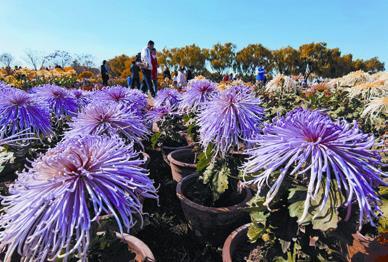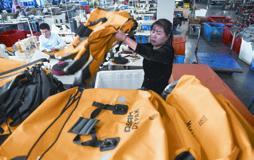THIRD WING
2020-11-20

Workers put fi nishing touches on the third terminal at the Guiyang Longdongbao International Airport in Guiyang, Guizhou Province in southwest China, on November 11.
The third-phase expansion project was contracted to China Construction Third Engineering Bureau. The new terminal is scheduled to start operation in 2021.

Autumn Blossom
Tourists visit the chrysanthemum park in Luanxie, a village in Shahe, Hebei Province in north China, on November 8. The village is growing improved varieties of chrysanthemum to develop rural tourism. The park has over 500 varieties of the fl ower.
Cold-Chain Risk
The Joint Prevention and Control Mechanism of the State Council for novel coronavirus disease(COVID-19) released a plan on November 9, outlining measures for full-chain, closed-loop and traceable management of imported coldchain foods.
To block the transmission of COVID-19 through imported coldchain foods, complete disinfection of such products will be carried out and tests conducted at the ports.
For imported cold-chain foods that test negative for the virus, the interiors of the cold -chain vans and outer packaging of the foods should be disinfected before they are transported. The foods that test positive for COVID-19 will be returned or destroyed.
Cold-chain logistics fi rms should check customs clearance documents for imported cold-chain foods and disinfect vehicles, ships and other transportation equipment. Workers who have direct contact with the foods should take protective measures.
Cold storages should keep records of imported cold-chain foods coming in and out. The records should be kept for at least two years. It should be ensured that all imported cold-chain foods entering the market are traceable.
In addition, ports should improve their customs clearance effi ciency to avoid overstocking and safeguard the stability of the industrial and supply chains.
Soybean Record
A new variety of soybean developed in Heilongjiang Province in northeast China has produced a record per unit yield in the region, local agricultural authorities said on November 9.
The northeastern region is the main soybean production base in the country, with Heilongjiang accounting for nearly half of the total soybean planting area in China.
The new variety, which was planted in a test area of around 0.35 hectare, achieved a yield of over 1,690 kg, translating to a record-breaking per-hectare yield of 5,043 kg.
The variety has also shown resistance to unfavorable conditions, according to Huang Chunfeng, a researcher with the provincial plant breeding technical service center which developed the seed.
“The new record shows we still have much room for improving the soybean yield in northeast China,”Huang said. “We should speed up upgrading to the better variety.”
Electric Heating
About 5 million residents in Shanxi Province in north China will benefi t from electric heating this winter.
Shanxi launched a campaign to shift the winter heating source from coal to electricity in 2017. As of 2019, more than 3.57 million households in the province had benefi ted from greener heating, cutting coal consumption by nearly 14 million tons. An additional of over 1.37 million households can use electric heating this year, which is estimated to reduce sulfur dioxide emissions by nearly 300,000 tons.
Greener heating will improve air quality in Shanxi. By October 11, the number of days with good air quality accounted for 70.1 percent, an increase of 9.9 percentage points year on year.
Poverty Alleviation
The construction of an information service system for Internet-based poverty alleviation has been basically completed in China. Telemedicine now covers all county-level hospitals in poverty-stricken counties, according to a press conference on November 6.
Internet-based services have been stepped up since 2016, through increasing network coverage and promoting rural e-commerce, to boost the development of impoverished areas, Yang Xiaowei, deputy head of the Cyberspace Administration of China, said.
Fiber optic availability in poor villages has risen to 98 percent, up from less than 70 percent, and the rural e-commerce promotion project now covers 832 poor counties.
The rural areas have witnessed an increase in online retail sales, with 1.7 trillion yuan ($256.8 billion) of purchases made in 2019, up from 180 billion yuan ($27 billion) in 2014.
Plant Fossil
Chinese researchers have found a dinosaur-era plant fossil with leaves and fruits of different morphologies dating back about 125 million years in Lingyuan City, Liaoning Province in northeast China, Xinhua News Agency reported on November 10.
The plant, the Varifructus lingyuanesis, provides rare raw material for evaluating the evolution of fl owers in the Early Cretaceous, the period about 145 million to 100 million years ago, according to Wang Xin, head of the research team from Nanjing Institute of Geology and Paleontology, Chinese Academy of Sciences.
The discovery was made by the team and scholars from Fujian Agriculture and Forestry University in southeast China.
The preserved part of the plant is about 17 cm long and 12 cm wide, and includes multiple physically connected organs such as branches, leaves, a bud and fruits. The fruits are arranged in asymmetrical pairs, and two branching patterns are seen in this single specimen.
The plant is a type of angiosperm, the most advanced, diversifi ed, and widely distributed plant group in the current ecosystem. But organs of most angiosperms nowadays have the same morphology, unlike the one found in the fossil.
“These variable patterns within a single plant indicate the morpholog- ical plasticity of angiosperms during the early period of their evolution,”Wang said.
The research fi ndings have been published in the journal Historical Biology.

Cultural Charm
Actors from the Shanghai Kunju Opera Troupe perform during the First Guangdong-Hong Kong-Macao Greater Bay Area Chinese Opera Culture Festival in Macao Special Administrative Region on November 5. Peking Opera, Kun Opera, Yu Opera and Cantonese Opera were featured at the event.
Deepest Canyon
The Yarlung Zangbo Grand Canyon in Tibet Autonomous Region in southwest China, the worlds deepest canyon with a maximum depth of 6,009 meters, was given 5A-level tourist attraction rating, the highest in the country, on November 10.
The 504.6-km canyon, located in Mainling County in Nyingchi along the lower reaches of the Yarlung Zangbo River, is also the longest canyon in the world.
The canyon was rated as a 4A-level national tourist attraction in 2010. The scenic area received 456,000 tourists in 2019, generating revenue of nearly 100 million yuan ($15.1 million).
In 2015, Tibet Tourism Co. Ltd. invested 329 million yuan ($50 million) and worked with the county government to upgrade the scenic area, adding new tourist facilities, including cliff swings, as well as more recreational programs such as hot spring bath and hot air balloon ride.
The company said it would step up ropeway construction, capital investment and smart management of the scenic area.
Tibet currently has fi ve 5A-level tourist attractions. The other four are the Potala Palace, the Jokhang Temple, the Tashi Lhunpo Monastery and Basum Lake.

Fire Drill
A primary school in Xingtai, Hebei Province in north China, conducts a fi re drill on November 9, national Fire Prevention Day.
Mongolian Sheep
Hubei Province in central China on November 9 sent the fi rst batch of 10 container trucks to Inner Mongolia Autonomous Region in north China to pick up the sheep gifted by Mongolia.
The fi rst herd of 4,000 sheep, gifted to support Chinas fi ght against COVID-19, arrived in ChinaMongolia border city Erenhot on October 22.
The trucks were sent by Wuhan Asia-Europe Logistics. For epidemic control, all trucks and containers had been disinfected a week before departure, and all the drivers, as well as other riders, had gone through nucleic acid tests.
Mongolian President Khaltmaa Battulga visited China in February at the critical stage of epidemic prevention and control in China and said Mongolia would present 30,000 sheep as a token of support.
Trade Plan
The State Council unveiled a set of guidelines on innovative foreign trade development on November 9.
China will negotiate and sign more high-standard free trade agreements and regional trade agreements while leveraging new technologies and channels to explore the international market, according to the guidelines.
Efforts will be made to enhance trade quality in the eastern region, increase the proportion of trade in the central and western regions, and expand the opening up of the northeastern region, while innovating mechanisms to foster cooperation among different regions.
The guidelines said the authorities should offer a targeted guide to different types of enterprises to foster the competitiveness of both large fi rms and small and mediumsized enterprises.
They also specifi ed measures to improve the structure of exports and imports, cultivate innovative trade modes, and foster trade facilitation platforms.
China has managed to keep foreign trade stable this year despite disruptions by the novel coronavirus disease (COVID-19) pandemic.
In the fi rst 10 months of the year, foreign trade in goods went up 1.1 percent year on year, accelerating from an increase of 0.7 percent in the fi rst three quarters, customs data showed.
Accelerated Recovery
Recovery of small and mediumsized enterprises (SMEs) improved throughout October, industry data showed on November 10.
The Small and Medium Enterprises Development Index, based on a survey of 3,000 companies, went up by 0.1 point, to 87 in the month, hitting a new high since February, according to the China Association of Small and Medium Enterprises.
The index contains multiple subindexes to gauge the performance and expectations of SMEs. A reading below 100 indicates dented vitality.
In October, the sub-indexes for the sentiment on the macroeconomy, operating cost, labor force and fi nancing rose above 100, suggesting an upward trend in business.
In general, nearly 97 percent of surveyed fi rms resumed operations. In the accommodation and catering industry, which was hit hard by the COVID-19 epidemic, the proportion was 94 percent.
The survey also showed eased cash strain, increased operating results, and stable investment enthusiasm among the fi rms, citing pro-SME measures such as policies to lower fi nancing costs.
Fifty percent of the respondents reported a rise in output, 40 percent saw more orders from domestic and overseas clients, and 60 percent registered an increase in sales prices.

Entry Into Service
A China-developed ARJ21 jetliner passes a water gate at the Chongqing Jiangbei International Airport in Chongqing, southwest China, on November 10. It will join the fl eet of China Express Airlines, a private regional carrier. This is the 39th ARJ21 aircraft delivered into the market since the fi rst one was put in service in 2016.
Patent Development
The number of invention patent applications on the Chinese mainland exceeded 1.23 million during the fi rst 10 months of the year, up 11.2 percent year on year, according to the National Intellectual Property Administration (NIPA).
During the same period, 55,000 applications were fi led and accepted via the World Intellectual Property Organizations patent cooperation treaty system, Shen Changyu, head of NIPA, said at the opening ceremony of the 12th China International Patent Fair in Dalian, Liaoning Province in northeast China, on November 11.
Chinas total amount of intellectual property pledge fi nancing hit 166.4 billion yuan ($25 billion) in the months, a year-on-year increase of 35 percent, and is likely to exceed 200 billion yuan ($30 billion) for the whole year.
In the fi rst eight months of the year, the import and export volume of intellectual property royalties totaled $29.13 billion ($4.39 billion), up 4.2 percent over the previous year, with export volume reaching $5.58 billion ($840 million), an increase of 26.4 percent.
ICT Forecast
Chinas information and communication technology (ICT) sector will continue to expand in 2021, an industrial report released on November 10, said.
The market is expected to reach $711.1 billion in 2021, up 9.3 percent from 2020, according to the global market intelligence f rim International Data Corporation.
The expenditure on digital transformation is estimated to reach$1.5 trillion in the 2021-24 period, with an average annual growth rate of 17 percent.
As of 2025, the digital economy is expected to account for 70 percent of the GDP, boosted by new infrastructure, dual circulation and technological self-reliance strategies.

Skill Show
A contestant takes part in a combine harvester troubleshooting event during a national farming skill competition in Weifang, Shandong Province in east China, on November 9.
Greener Banks
International Finance Corporation(IFC), a member of the World Bank Group, signed a new partnership with the Hong Kong Monetary Authority (HKMA) on November 9, encouraging commercial banks in Asia to adopt innovative strategies and targets to become greener.
It made HKMA the fi rst partner to work with IFC on the initiative to help develop green commercial banks and promote more green fi nance in order to address climate change, a statement of the government of Hong Kong Special Administrative Region said.
“HKMA is keenly aware that the battle against climate change requires a global collective effort, and that the fi nancial sector will play a crucial role in developing green and sustainable fi nance,” Eddie Yue, Chief Executive of HKMA, said.
Under the agreement, over the next fi ve years, HKMA and IFC will bring together fi nancial institutions, banking industry associations, research institutions, and innovative technology providers from across Asia to develop, build, and boost the capacity for green fi nance as well as stimulate climate investment.
IFC research estimates that cities in emerging markets alone have the potential to attract more than $29 trillion in climate-related investment by 2030. The Asia-Pacifi c region has the highest climate-smart investment potential in the world.
Lending Scrutiny
The China Banking and Insurance Regulatory Commission, along with the Peoples Bank of China, the central bank, started seeking public opinion on the interim measures for the administration of online small lending on November 4.
Many microloan companies expanded online small lending quickly all over the country, breaking regulatory restrictions that prevent them from doing business across provinces, China Daily reported, quoted Dong Ximiao, chief analyst at the Zhongguancun Internet Finance Institute, as saying.
“These companies sought sources of funding through measures including issuing assetbacked securities, which has sharply increased their fi nancial leverage ratios. Some Internet companies, in particular, entered the fi eld of small lending barbarously, adopted an extensive model of management, infringed on consumer rights, and might adversely affect fi nancial stability,” Dong said.
For a microloan company that runs online small lending business, its balance of fi nancing through issuance of standard credit assets including bonds and asset-backed securities should not exceed four times its net assets, according to the draft measures.
The balance of online small loans issued to an individual should not exceed 300,000 yuan ($44,836) and also cannot surpass one third of his or her average annual income in the last three years.
“This requirement will signifi -cantly affect microloan companiesclient base, as borrowers without stable incomes or certifi cate of income may not receive online small loans from these lenders,” Zeng Gang, Deputy Director General of the National Institution for Finance and Development, said.
The draft rules also require microloan companies to provide at least 30 percent of loan funds for each online small loan they offer jointly with commercial banks. This will force microloan companies to cut down their fi nancial leverage, experts said.
Currently, 249 microloan companies are authorized to run online small lending business in China.

Alternative Way
A worker checks the inventory at Yige Outdoor Products Co. Ltd. in Fuzhou, Fujian Province in southeast China, on November 10. The company has shifted its focus to the domestic market due to the coronavirus-caused decline in overseas demand and is exploring new business opportunities both online and offl ine.
